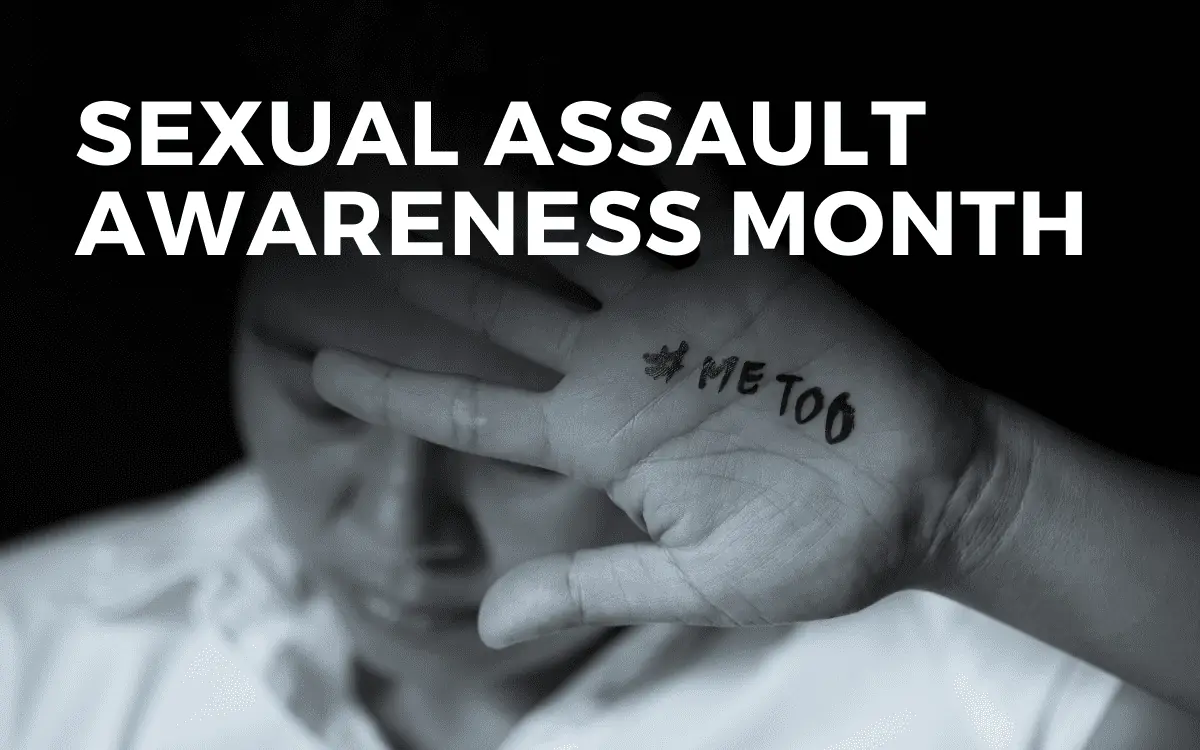Sexual assault awareness month is an important time of year to recognize and talk about the issue of sexual violence. It’s an opportunity for us to assemble as allies, sufferers, promoters, and community members to voice our backing of approaches that can aid in decreasing the danger of sexual assault. In this article, we’ll explore ways to celebrate sexual assault awareness month and how to spread public awareness about sexual violence, the types of sexual assault, consent, and respectful relationships, resources available for survivors and allies alike, as well as statistics on sexual violence.

When is Sexual Assault Awareness Month?
Sexual Assault Awareness Month (SAAM) takes place in April each year. It’s an annual campaign to raise public awareness about sexual violence and educate communities on how to prevent it.
History of Sexual Assault Awareness Month
In 2001, the National Sexual Violence Resource Center (NSVRC) launched Sexual Assault Awareness Month to raise public understanding of sexual violence and provide education on how it can be prevented.
The origins of SAAM can be traced back to 1981 when Take Back the Night marches began in Europe as a way for survivors of sexual violence to reclaim their safety and power. In April 2001, the NSVRC declared April as “National Sexual Assault Awareness Month” in response to these marches. Since then, each year has seen more events and initiatives organized around raising awareness about this issue.
SAAM’s objectives are to promote education, prevention, survivor support, and the advocacy of policy changes at all levels to ensure that everyone is part of preventing sexual violence by recognizing consent as essential for healthy relationships. This involves recognizing consent as fundamental for healthy relationships; instructing young people on how they can safeguard themselves from becoming victims or perpetrators; increasing access to resources such as hotlines and shelters; providing services like counseling for survivors so they may recover from their experiences with trauma-informed care. Additionally, SAAM strives towards altering attitudes that shift blame onto the victim instead of keeping perpetrators responsible for their actions.
How to Celebrate Sexual Assault Awareness Month
Sexual Assault Awareness Month is an essential opportunity each year to increase public awareness about sexual violence, advocate for consent-based healthy relationships, and educate communities on how to prevent it. Here are some ideas to help raise awareness:
- Create a Sexual Assault Awareness Month campaign in your workplace, school, or community. This could be anything from creating handouts with information on sexual violence to hosting a fundraiser for a local organization that supports survivors of sexual assault.
- Take the pledge to become an active bystander and intervene if you ever witness acts of sexual violence.
- Host a Sexual Assault Awareness Month event such as a panel discussion, film screening, or art exhibit featuring work from survivors of sexual assault.
- Wear teal, the official Sexual Assault Awareness Month color, to signify your support for survivors and to recognize that sexual assault is a serious issue.
- Donate or volunteer at an organization that provides services to survivors of sexual assault.
- Educate yourself on sexual violence and consent by attending workshops or reading articles about the topic.
- Spread awareness by talking to your friends and family about Sexual Assault Awareness Month.
- Participate in marches or other events organized by local organizations to show your support for survivors of sexual assault.
- Share posts on social media about Sexual Assault Awareness Month to increase awareness and show your support for survivors.
Hashtags and Social Media Ideas for Sexual Assault Awareness Month
Social media is a powerful platform to amplify Sexual Assault Awareness Month and show support for survivors of sexual assault.
Here are some ideas of what to post on social media throughout the month:
- Share resources for survivors of sexual assault– such as hotlines, shelters, and counseling services – in your social media posts.
- Post stories from survivors of sexual assault to show the importance of Sexual Assault Awareness Month and to emphasize that these types of crimes should not be tolerated.
- Remind your followers how they can be active bystanders by intervening if they ever witness acts of sexual violence.
- Encourage others to take the pledge to become an active bystander and end sexual violence in our communities.
- Share graphics or quotes about Sexual Assault Awareness Month that educate people on how to prevent it.
- Show your support for Sexual Assault Awareness Month by sharing a photo of you wearing teal – the official SAAM color.
- Raise awareness about Sexual Assault Awareness Month by posting tips on how to talk to kids about consent, healthy relationships, and identifying sexual violence.
- Highlight Sexual Assault Awareness Month events happening in your community, such as Take Back the Night marches or panel discussions.
When sharing posts on social media, be sure to use hashtags relevant to SAAM to increase the exposure and reach of your posts. Use hashtags such as:
- #sexualassaultawarenessmonth
- #sexualassaultawareness
- #sexualassault
- #metoo
- #nomeansno
- #consent
Millions of posts across various social media platforms such as Twitter, Instagram, and Facebook have utilized these hashtags to raise awareness about sexual violence prevention. They help spread the message that victims of sexual assault should be believed and supported while perpetrators should be held accountable for their actions.
For the complete list of holidays to celebrate on social media in April, visit angiegensler.com/april-holidays
Other Holidays Related to Sexual Assault Awareness Month
The first Tuesday of every April is the Sexual Assault Awareness Month (SAAM) Day of Action. On this day, people join forces to create awareness surrounding sexual violence and take action to put an end to it. The day is dedicated to providing strategies for prevention and advocacy, as well as educating individuals on how they can be active bystanders.
Denim Day is an international event where people wear jeans to protest victim-blaming and show solidarity with survivors of sexual assault. It takes place each year on the last Wednesday of April. The origins of Denim Day are traced back to a 1999 Italian Supreme Court ruling that overturned a rape conviction because the survivor was wearing tight jeans, implying that she had consented to sexual activity. Since then, people all over the world have come together in protest of this ruling and to show their support for survivors.
Sexual Assault Awareness Week (April 24th-30th): This week is dedicated to raising awareness and encouraging the prevention of sexual violence. It’s a time for individuals, organizations, and communities to come together and create lasting change by engaging in conversations about consent, respect, and healthy relationships. –
Take Back the Night – Designed to provide support for survivors of Sexual Assault, Take Back the Night is a series of events and activities held around the country. It’s a way for local communities to come together and create safer environments for everyone, regardless of age or gender identity/expression.
Domestic Violence Awareness Month is an annual campaign that takes place in October. The goal is to raise awareness about the impact of domestic violence and work together to create a society free from abuse. During this month, organizations come together to provide resources and education on how to recognize abuse and take action against it. It’s also a time for survivors to connect with support services and for communities to hold vigils and other events in honor of those affected by domestic violence.
These are just a few of the holidays related to Sexual Assault Awareness Month that you can get involved in on social media. By making a commitment to educating yourself and others about Sexual Assault Awareness
For more holidays, download our free calendar with over 1,000 fun and unique holidays to celebrate this year. Head to angiegensler.com/holiday-calendar to grab your free copy!
National Sexual Assault Awareness Month Dates
| Year | Date | Day |
|---|---|---|
| 2024 | April 1 | Monday |
| 2025 | April 1 | Tuesday |
| 2026 | April 1 | Wednesday |
| 2027 | April 1 | Thursday |
| 2028 | April 1 | Saturday |
| 2029 | April 1 | Sunday |
Types of Sexual Assault
Sexual assault is any unwanted sexual contact, from touching to rape. It’s a form of violence that can be physical, psychological, or both. It’s important to understand the different types of sexual assault and their effects on victims and survivors in order to create safer environments for everyone.
Non-consensual sexual contact or activity, which may be carried out due to age, intoxication, disability, fear, etc., is defined as sexual assault. This includes rape and attempted rape; unwanted kissing; groping; inappropriate comments about someone’s body; sharing intimate photos without permission; stalking; cyberbullying with a sexual component; voyeurism (peeping); exhibitionism (flashing); incest (sexual relations between family members); date/acquaintance rape drugs such as Rohypnol and GHB (gamma hydroxybutyrate).
Forced oral sex and unwanted sexual touching are two examples of sexual assault. Other forms may include making threats against someone if they don’t comply with certain requests, such as sending nude pictures over the internet or participating in other activities which make them feel uncomfortable. Additionally, some people may experience emotional abuse, such as name-calling during an attack which can also constitute a form of sexual assault.
Sexual assault is a serious crime that can have lasting impacts on victims and survivors, making it important to understand the types of sexual assault. By understanding the dynamics of consent and building healthy relationships, we can create a safe atmosphere that encourages respect for all.
Consent and Respectful Relationships
Consent is the voluntary agreement to engage in sexual activity. It’s an ongoing process that requires clear communication and mutual respect. Without consent, any form of sexual contact or behavior can be considered assault or rape. Trust, truthfulness, and candid discourse are the foundations of harmonious relationships. When both parties feel secure and esteemed, it can make a conducive environment for boundaries to be set up, which empowers them to express their requirements and wants.
Forming a courteous connection necessitates delineating limits from the outset; this implies comprehending what you desire out of the association and additionally what your partner wants from it too. Establishing these expectations early on will help ensure that everyone involved feels comfortable and respected throughout the duration of the relationship. Additionally, being mindful about how you treat each other is important; even if there’s a disagreement between partners, they should still strive to remain respectful towards one another by avoiding name-calling or belittling language when communicating with each other.
Grasping the notion of consent and fostering respectful interactions with others is imperative. By educating ourselves on these topics, we can better support survivors of sexual assault and their allies in our community. Supportive services such as hotlines, legal help, and other forms of aid are obtainable for those affected by sexual assault and their allies.
Resources for Survivors and Allies
For survivors of sexual assault, there are many hotlines and support groups offering free, confidential resources. These organizations provide a range of free, confidential support services like counseling, legal help, and advice, medical aid referrals, and emergency assistance. Hotline numbers vary by state or region, but most offer 24/7 service in multiple languages. Moreover, survivors of sexual violence may find solace in support groups tailored to their specific needs.
Organizations offering legal help to those who have experienced sexual assault or abuse can be found; they offer free or low-cost services, specializing in areas such as civil litigation for harassment cases, criminal defense against perpetrators of sexual violence, immigration issues faced by survivors from abroad, and more. These organizations often specialize in areas such as civil litigation related to sexual harassment cases, criminal defense against perpetrators of sexual violence, immigration issues faced by survivors from other countries, and much more. Survivors should be aware of their legal rights in order to make educated choices regarding any possible court proceedings.
Supporting survivors does not always mean going through official channels, such as filing police reports or attending court hearings. There are plenty of ways to show our solidarity with victims on an individual level, like sending a card offering words of encouragement or checking in via text message. Additionally, we can join forces with local advocacy organizations by volunteering at events that raise awareness about preventing future incidents from occurring. Using social media platforms is also an effective way to spread messages promoting respect towards all individuals regardless of gender identity or sexuality while amplifying voices belonging to marginalized communities disproportionately affected by this issue.
Survivors of sexual assault must have access to resources and aid. By learning more about prevention strategies, we can work together to create a safer world for everyone. It is important to take steps towards lessening the danger of sexual assault by implementing preventative actions in our neighborhoods and teaching youth about giving consent.
Prevention Strategies for Reducing the Risk of Sexual Violence
Preventing sexual violence is essential for reducing the risk of harm and creating safe environments. Creating safe environments at home, school, work, and other settings is essential for keeping everyone safe from harm. Here are some strategies for creating such an environment.
At Home
Establish clear boundaries about acceptable behavior in your home and make sure all family members understand them. Set up a system where any violations of these boundaries can be reported without fear of retribution or judgment. Encourage open communication between parents and children so that they feel comfortable discussing difficult topics like consent and respect in relationships.
At School
Educate students on healthy relationship dynamics through age-appropriate lessons that focus on building empathy, understanding boundaries, recognizing signs of abuse, and developing skills to de-escalate conflict situations. Make sure staff are trained to recognize signs of potential abuse or exploitation so they can take appropriate action when necessary.
At Work
Promote policies around respectful workplace behavior by providing resources such as training materials and anonymous reporting systems for employees who experience harassment or discrimination based on gender identity or expression. Encourage coworkers to intervene if they see someone being mistreated or disrespected in the workplace.
Stopping sexual assault is a vital part of constructing secure and healthy atmospheres for all. Understanding the statistics on sexual violence can help us further understand its prevalence, impact, and trends over time.
Statistics on Sexual Violence
Statistics related to sexual assault are an integral part of comprehending the scale and prevalence of this problem. Prevalence rates can be measured in terms of lifetime experience, annual incidence, or both. NISVS states that roughly one-third of women and one-sixth of men have experienced sexual violence in their lifetime, highlighting the scale and prevalence of this issue.
A 2023 poll revealed that almost half (46%) of females experienced unwanted sexual conduct in the past 12 months. NISVS findings indicate that Black people are twice as likely to experience rape than white people, transgender individuals face a greater risk of intimate partner violence than cisgender individuals, and disabled adults report higher rates of rape in comparison with non-disabled adults. Undocumented immigrants also encounter particular impediments when attempting to report abuse or gain access to services for survivors.
With an understanding of the prevalence of sexual violence, it is essential to stay informed about related statistics in order to support effective prevention initiatives. Hashtags and social media can be potent means of spreading the word about stopping sexual violence; here are some successful examples.
Conclusion
In conclusion, Sexual Assault Awareness Month serves as a reminder to take action against sexual violence and work towards creating a safe world for everyone. Prevention strategies, such as setting boundaries at home, educating students on healthy relationship dynamics, and promoting respectful workplace behavior, can help reduce the risk of harm. By taking the necessary steps to address this issue, we can work together toward creating a world free of sexual violence.
{“@context”:”https://schema.org”,”@type”:”FAQPage”,”mainEntity”:[{“@type”:”Question”,”name”:”What is the point of Sexual Assault Awareness Month?”,”acceptedAnswer”:{“@type”:”Answer”,”text”:”SAAM is a yearly event in April to spread knowledge of sexual assault and how to stop it, aiming to recognize the severity of this crime while providing survivors with assistance for healing. The aim of SAAM is to emphasize the gravity of sexual assault, support survivors in their journey towards recovery, and empower bystanders to take action when they witness inappropriate behavior. It also seeks to create social change by encouraging bystanders to intervene when they see something wrong or inappropriate happening around them. By doing this, we can all help create safer environments for everyone.
“}},{“@type”:”Question”,”name”:”What is the theme of 2023 Sexual Assault Awareness Month?”,”acceptedAnswer”:{“@type”:”Answer”,”text”:”The theme of 2023 Sexual Assault Awareness Month is… Can Build a World Free From Sexual Violence. This theme emphasizes the importance of creating and maintaining safe, respectful environments that foster healthy relationships between individuals, communities, and institutions. It also encourages everyone to work together to end sexual violence by speaking out against it in all its forms, supporting survivors, and holding perpetrators accountable for their actions. The objective is to cultivate a setting where everyone can feel secure from any type of sexual maltreatment or abuse, so that we may construct a world devoid of such injury.
“}},{“@type”:”Question”,”name”:”When is Sexual Assault Awareness Month?”,”acceptedAnswer”:{“@type”:”Answer”,”text”:”Sexual Assault Awareness Month (SAAM) is takes place in April each year. It’s an annual campaign to raise public awareness about sexual violence and educate communities on how to prevent it.
“}},{“@type”:”Question”,”name”:”What are Hashtags and Social Media Ideas for Sexual Assault Awareness Month?”,”acceptedAnswer”:{“@type”:”Answer”,”text”:”When sharing posts on social media, be sure to use hashtags relevant to SAAM to increase the exposure and reach of your posts. Use hashtags such as: #sexualassaultawarenessmonth #sexualassaultawareness #sexualassault #metoo #nomeansno #consent Millions of posts across various social media platforms such as Twitter, Instagram, and Facebook have utilized these hashtags to raise awareness about sexual violence prevention. They help spread the message that victims of sexual assault should be believed and supported while perpetrators should be held accountable for their actions.
“}}]}














